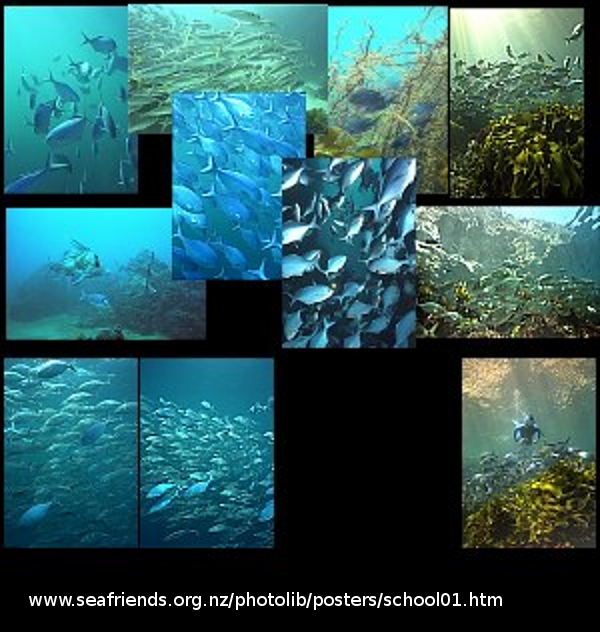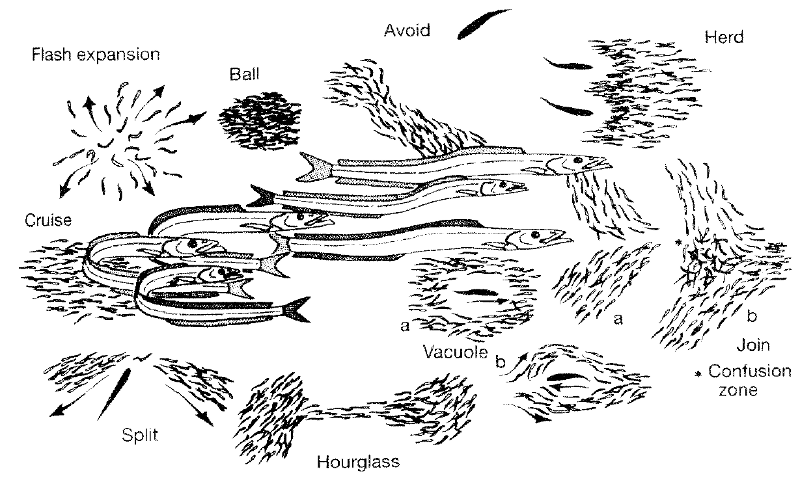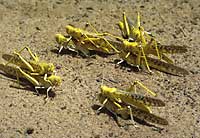Animal collective behaviour
In the structure section we present some of the basic concepts to analyze the structure of complex networks, whereas this section is devoted to present some of the concepts that have been developed to study collective behaviour in nature, particularly large groups of animals, such as swarms, herds, schools of fishes, and flocks. High population densities usually led to negative consequences as increased competition for resources, disease trnasmission, and attention for predators, but species that take advantage of dense populations to form organized groups may benefit by more effective foraging, reproduction, migration and escape from predators.
Heterogeneous, "aggregated" patterns in the spatial distributions of individuals are almost universal across living organisms. What are the individual-level behavioral traits that give rise to these features? Mathematical models of social behaviors suchs as schooling in fishes, swarming in ants, of flocking in birds provide a promising avenue to address some of these questions. Physical aggregation can be regarded as part of a continuum in group integration, Honeybees hives, cetacean pods and human communities are examples of theses integrated groups. Between these extremes of group integration are what could be considered "prototypical" animal aggregation, herds, swarms, flocks and schools. Many of these groups are extremely large (e.g. a school of a billion herring). Individuals in such groups interact with a neighborhood of the other members, but those may represent a quite small fraction of the group as a whole. This suggests that mechanisms that maximize information tranfer among individuals could be beneficial.
Dynamic patterns and movement are necessary characterisitics of many biological aggregation, and are perhaps adavtive responses from environment phenomena. For example, fish schools display complex emergent properties such as coordinated motion and directed activity. Compression, vacuole, fountain, and flash explansion are all maneuvers that maximize predatory risk only if all members perfom them correctly.


Examples of coordinated movements and directed activity, both directed activity of fish schools. (Taken without permission from the autor ref [9])
One of the simplest models to describe swarming systems was proposed by Vicseck and collaborators in 1995. The model is "simple" in the sense that the interactions used to describe the particles in the system are easy to formulate and implement for computer simulations. However, it has been extremely difficult to characterize its dynamical properties either analitically or numerically. We will present a deeper description about this model a bit later.
There have been other proposals that describes group movements. Iain Couzin of Princeton University has used data on several species of fish and insects to built a generic model. His model shows that only a tiny number of "informed" individuals, those familiar with the food source or migration path, are required to bring around the whole group. They presented this work in Nature in 2005. Couzin and collaborators filmed a band of locusts circling a dome in the lab, which gives the locust the impression they are in an endless swarm.
What behavioral mechanisms are involved in this information tranfer in locusts and other animal groups? Their study's key message is that two distinct transitions in group level directionality ocurr as locusts become crowded. At low population density, locusts, tend to have random orientations and do not align with each other. Because locusts interact only over relatively short distances, neighbors who are not aligned move quickly apart and thereafter little effect on each other. Just as liquid water can suddenly begin to boil (phase transition), due to pressure and temperature, animal swarms can also change abruptly thanks to some simple rules.
For locusts, the first transition occurs at intermediate density (24.6 per square meter), the insects began to march together, behaving like magnetic particles, which also start to align at increased densities. But the group ocasionally made rapid, spontaneous changes in direction without losing cohesion. By the time densities reach 73.8 per square meter, the locusts surged along as one, with no direction changes, that is characteristic of locust migration in nature.

 Source
Source